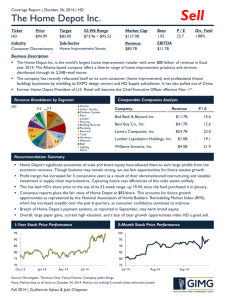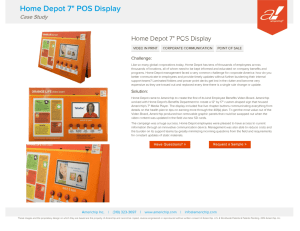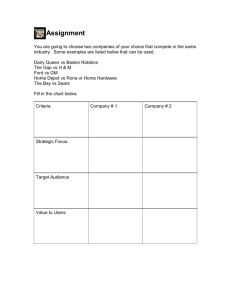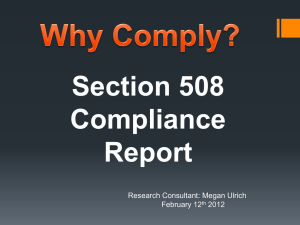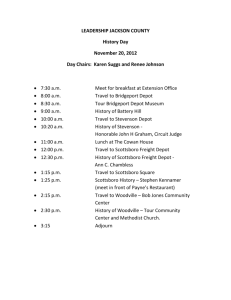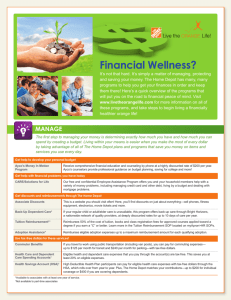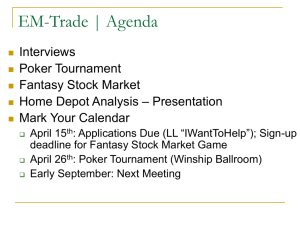Section 1 - CaseStudyGroup2
advertisement
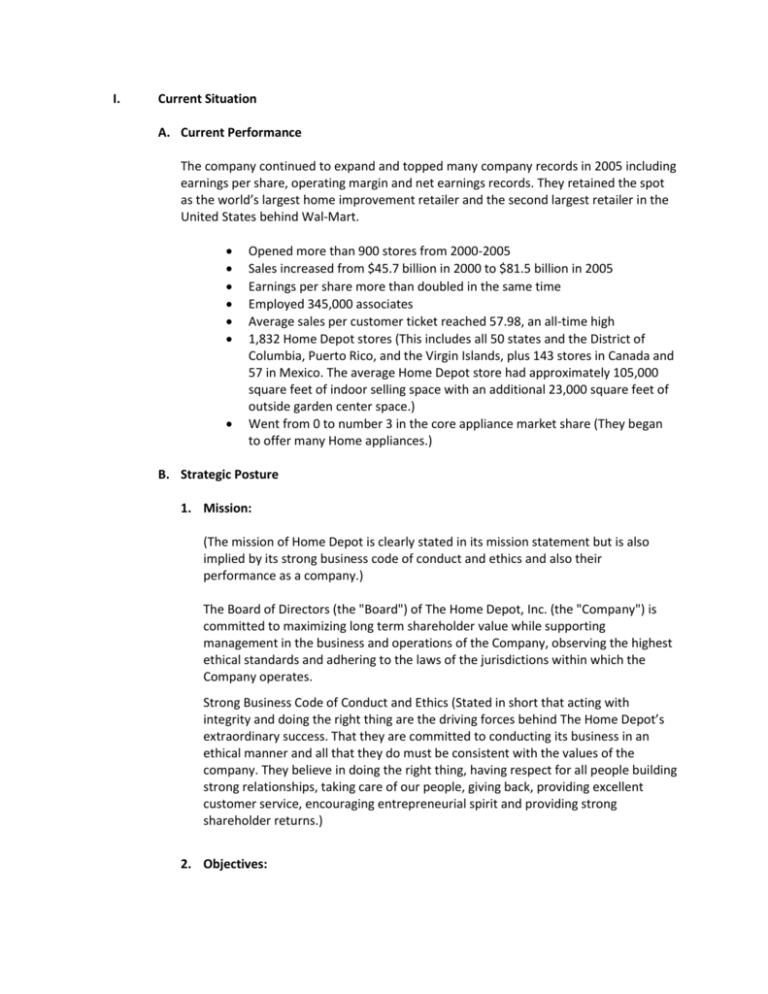
I. Current Situation A. Current Performance The company continued to expand and topped many company records in 2005 including earnings per share, operating margin and net earnings records. They retained the spot as the world’s largest home improvement retailer and the second largest retailer in the United States behind Wal-Mart. Opened more than 900 stores from 2000-2005 Sales increased from $45.7 billion in 2000 to $81.5 billion in 2005 Earnings per share more than doubled in the same time Employed 345,000 associates Average sales per customer ticket reached 57.98, an all-time high 1,832 Home Depot stores (This includes all 50 states and the District of Columbia, Puerto Rico, and the Virgin Islands, plus 143 stores in Canada and 57 in Mexico. The average Home Depot store had approximately 105,000 square feet of indoor selling space with an additional 23,000 square feet of outside garden center space.) Went from 0 to number 3 in the core appliance market share (They began to offer many Home appliances.) B. Strategic Posture 1. Mission: (The mission of Home Depot is clearly stated in its mission statement but is also implied by its strong business code of conduct and ethics and also their performance as a company.) The Board of Directors (the "Board") of The Home Depot, Inc. (the "Company") is committed to maximizing long term shareholder value while supporting management in the business and operations of the Company, observing the highest ethical standards and adhering to the laws of the jurisdictions within which the Company operates. Strong Business Code of Conduct and Ethics (Stated in short that acting with integrity and doing the right thing are the driving forces behind The Home Depot’s extraordinary success. That they are committed to conducting its business in an ethical manner and all that they do must be consistent with the values of the company. They believe in doing the right thing, having respect for all people building strong relationships, taking care of our people, giving back, providing excellent customer service, encouraging entrepreneurial spirit and providing strong shareholder returns.) 2. Objectives: (There are many objectives that the company has as you can see but these objectives are strongly supported by the company’s strategies which will be verbalized in the next section.) Enhancing the Core, extending the business and expanding the market. Maintain and grow its leadership position in the home improvement retail worldwide. Become the nation’s largest diversified wholesale distributor Become number one in services (currently have more than 11,000 installations per day and expect to continue their growth through 2010) Become the largest home improvement retailer in both Canada and Mexico. Increase direct-to-consumer channels Compounded annual sales growth of 9%-12% Compounded earnings per share growth of 10%-14% Open 400-500 new stores (which will create an additional 40-55 million square feet of new selling space.) Increase operation margin Have a cumulative operating cash flow of $50 billion Cumulative capital expenditures of $17-20 billion Grow Home Depot Supply sales Increase efficiency Increase number of customers applying for credit 3. Strategies: Introduced self checkout, Back End Automation and Re-engineering and centralized automated replenishment. (These advancements in automation helped to successfully improve the efficiency of Home Depot’s operations.) Acquired 21 companies (These companies were acquired in an attempt to increase the amount of installations that Home Depot could perform. One of the major companies that Home Depot purchased was Hughes Supply.) Remain prepared for weather phenomenon such as hurricane Katrina. (Two days prior to Katrina making landfall maintenance teams battened down stores in the projected path of the hurricane and electrical generators and hundreds of extra workers were moved into place.) Served both the Do-It-Yourself (DIY) and Do-It-For-Me (DIFM) customer. Better serve the professional customer. (To do so, Home Depot acquired the previously stated 21 stores while the Home Depot Supply distributed products and sold installation services primarily to professional business contractors, businesses and municipalities. 1. They focused on three main areas. Supplying maintenance, repair and operating products to multifamily housing, hospitality and lodging facilities, 2. Builder provided products and arranged installation services for production homebuilders and 3. Providing specialty hardware, tools, and materials to construction contractors.) Modernize the stores while updating their product lines. (This strategy is in place to meet the objective of Enhancing the Core of the company. In order to enhance the company it must be able to adjust to changing customer needs.) Expand into multiple channels. (The objective to extend the business is met by expanding to channels such as homedpot.com and various catalogs and also by selling new products and services.) Expand into new markets. (The company plans on expanding into new markets with new products to better serve existing customers and to attract new ones.) Use technology to increase efficiency examples in clued computerized point of sale system, electronic bar code scanning system, and a UNIX server. (In so doing the associates will be able to spend more time serving and focusing on the customer. It will also help with the store-based inventory management, rapid order replenishment and item movement information.) Become Sustainable. ( In order to achieve sustainability Home Depot plans on selling products that are manufactured, packaged, and labeled in a responsible manner, that take the environment into consideration and that provide greater value to its customers.) Differentiate itself from its competitors through customer service. Employ only highly qualified and helpful employees. (This along with helpful in-store displays is done in an attempt to cultivate customers.) Demonstrate methods and techniques of performing a job safely and efficiently to the customer. (Instead of just recommending appropriate products, tools, and materials employees are urged to go the extra-mile and provide tips.) Offered credit programs and reduced charge card approval process time. (The approval process time had been reduced to less than 30 seconds to increase the number of customers applying for credit. In 2005 approximately 4 million new Home Depot credit accounts were opened, bringing the total number of Home Depot account holders to about 16 million. The credit card sales accounted for around 26% of store sales.) 4. Policies: Main Policies Improve everything we touch (The company adopted this slogan and policy after Nardelli became CEO and he stated that you can improve everything you touch whether you’re a lot attendant, store manager, or chairman of the company.) Superb Service Be a good corporate citizen Behave Ethically Act with integrity Prior to Bob Nardelli in December of 2005 Decentralized management and decision making. Entrepreneurial innovation and risk taking. High levels of employee commitment and enthusiasm. Bond with customers and the communities Orange-blooded culture which emphasized individuality, informality, nonconformity, growth and pride. (This allowed for ideas from employees to be heard by upper management because of the ease of information communication. Instead of conforming to other organizations Home Depot employed a bottom-to-top type of training sequence in which they trained the carryout people first because they believed that the last person to come in contact with the customer makes a huge impact and they wanted the contact to be positive.) (These policies were formed by the founders of the company. Some of the policies prior to Nardelli are still applied by the company but he changed it to a more centralized, military standard type of company. He did this because he believed it was partially responsible for the firm’s stagnation in sales growth.) After Bob Nadelli Centralized management Organize the company Emphasis on military efficiency Hire veterans Disciplined manager corps (This is done in an attempt to produce managers that follow orders, operate in high-pressure environments, and execute with high standards. (The new policies prohibited the constant flow of ideas and suggestions from employees in the organization and replaced it with major decisions and goals that flow down from top management. Some people used to the old way of doing things felt a “culture of fear” because instead of just using their experience to sell at their maximum the company set forth exact goals for each store. Customer satisfaction fell off in 2005 and some say it was because Nardelli tried to measure good customer service instead of inspiring it. In 2006 the customer satisfaction was improving.) II. Strategic Managers A. Board of Directors (Information) B. Top Management (Information) III. External Environment A. Natural Physical Environment: Sustainability Issues (Information) B. Societal Environment C. Task Environment IV. (Information) (Information) Internal Environment: Strengths and Weaknesses A. Corporate Structure (Information) B. Corporate Culture (Information) C. Corporate Resources 1. Marketing (Information) 2. Finance (Information) 3. Research and Development (Information) 4. Operations and Logistics (Information) 5. Human Resources Management (Information) 6. Information Technology V. (Information) Analysis of Strategic Factors A. Situational Analysis (SWOT) 1. Strengths (Information) 2. Weaknesses (Information) 3. Opportunities (Information) 4. Threats (Information) B. Review of Current Mission and Objectives Mission Statement (Information) Objective VI. (Information) Strategic Alternatives and Recommended Strategy A. Strategic Alternatives (Information) B. Recommended Strategy VII. Implementation A. What kinds of Programs Should be Developed to Implement the Recommended Strategy? (Information) B. Are the programs financially feasible? Can Pro Forma Budgets be developed and agreed on? Are priorities and timetables appropriate to individual programs? C. Will New Standard Operating Procedures Need to Be Developed? VIII. Evaluation and Control A. Is the current information system capable of Providing Sufficient Feedback on Implementation Activities and Performance? Can It Measure Strategic Factors? (Information) B. Are Adequate Control Measures in Place to Ensure Conformance with the Recommended Strategic Plan? (Information) Exhibit #1 D. Summary of External Factors External Factors Weight Rating Weighted Score Comments Opportunities 25 yr GSM license to operate in Turkey 0.05 3.6 0.18 Ensures stability Established standards GPRS advancement 0.05 3.2 0.16 MMIS for Outlook 0.05 3.9 0.2 Entrance into the EU customer relation and social responsibility 0.1 0.15 3 4.4 0.3 0.66 PDA like access Economic reliability Essential for businesses Threats Debt created by Lira nosedive Taxation of 66% 0.15 0.2 2.9 2.5 0.44 Slows margin profit 0.5 Decreases income Possible ten year wait for 3G profit Rural users uncertainty 0.1 2 0.05 Marketing campaigns too expensive 0.1 Totals 1 4.1 3.8 0.2 Long wait for profit 0.21 Need everyone onboard 0.38 Develop simpler ads 3.23 Exhibit #2 Table 5-2 Internal Factors Strengths: Quality known with name Highly trained employees Large market share 100% coverage Immediate response Internal Factor Analysis Summary Weight Rating Weighted Score Comments 0.1 0.15 0.1 0.2 0.15 4 5 3.4 4.7 4.6 0.4 0.75 0.34 0.94 0.69 snabbit icon 80% college degree small competition 5000+ populations troubleshooting Weaknesses: Potential customers do not understand mobile communications 3G technology is almost out of reach Government restrictions Total scores 0.15 2 0.05 0.1 2.3 1.6 need to educate 0.3 citizens 0.12 too expensive 0.16 taxes 1 3.7 Exhibit #4 Year Ending December 31 Assests Current Assets: Cash and cash equivalents Trade receivables Due from related parties Inventiories Prepaid expenses Other current assets 2001 2000 243,114 256,143 164,448 12,154 20,843 46,965 363,365 325,636 113,860 16,402 22,484 44,476 Total current assets Advances to related parties Due from related parties Prepaid expenses Investments Fixed assets Construction in progress Intagibles Other long-term assets Total Assets Liabilities and Shareholders' Equity Current Liabilities Short-term borrowings Trade payables Due to related parties Tax Payable Deferred tax liability Other current liabilities and accrued expenses Total Current Liabilities Long-term lease obligations Long-term lease obligations Retirement pay liability Deferred tax liabilities Minority interest Other long-term liabilites Shareholders' equity: Common Stock Additional paid in capital Advances for common stock Legal Reserves Accumulated other comprehensive loss Retained Earnings Total shareholders' equity Total Liabilities and Shareholders' equity $743,667 10,085 3,300 58,329 1,655,110 119,363 916,920 28,996 $3,535,770 $383,167 302,039 3,626 130 $886,223 1,020 11,765 60,068 1,762,168 233,299 892,995 37,382 $3,884,920 $438,081 208,890 2,811 21,103 303, 425 992,387 1,218,903 37,103 4,737 896 6,792 636,116 178 119 5 -1,875 650,682 1,285,225 3,546,043 271,194 942,079 1,600,676 34,472 3,545 3,491 12 5,838 458,239 141 5 -1,049 837,471 1,294,807 3,884,920 Exhibit #5 Exhibit #5 Revenues Direct cost of revenues 2002 2003 2004 1,973,850 2,219,237 3,200,765 - 1,366,899 1,613,150 2,001,223 Gross profit General and administrative expenses Selling and marketing expenses Operating income Income (expense) from related parties Interest income Interest expense Other income, net Equity in net (loss) income of unconsolidated investees Minority interest in income of consolidated subsidiaries Translation loss Income (loss) before taxes Income tax benefit (expense) Net income 606,951 -104,523 -223,496 278,932 -225 95,548 -302,335 13,560 606,087 1,199,542 -137,222 -137,315 -294,611 -349,249 174,254 712,978 3,738 1,919 117,240 152,751 -483,622 -121,500 6,190 7,113 -20,392 18,927 43,646 333 -18,045 47,376 3,558 -102,403 -262,118 477,285 215,167 7,466 -11,192 793,181 -281,360 511,821 47,376
